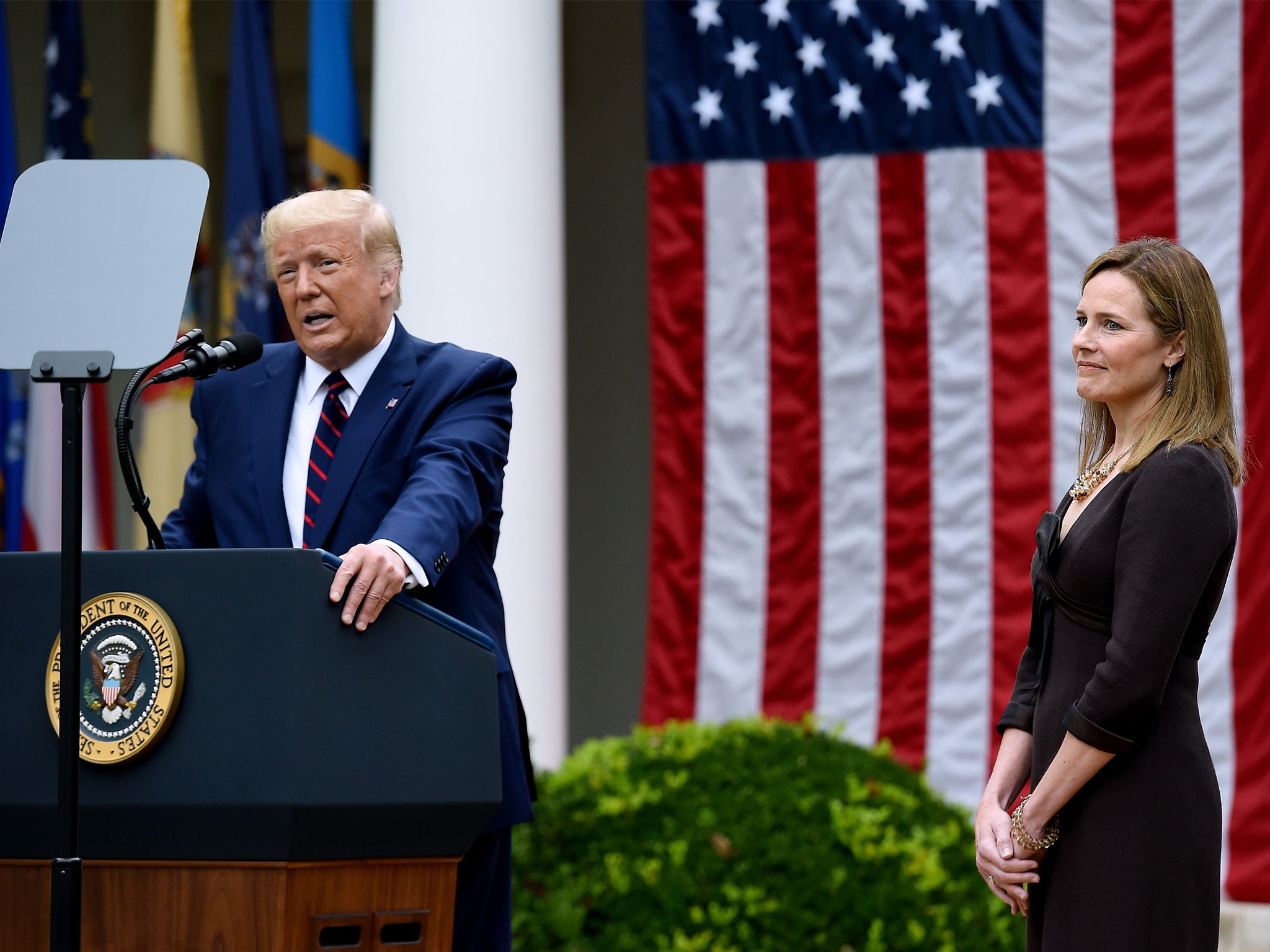Culture wars, Amy Coney Barrett and Covid comes home
In the 19th instalment of our series recapping an unprecedented presidency, Joe Sommerlad looks at Republican gamesmanship on the Supreme Court, the first presidential debate and the inevitable happening


Donald Trump began July 2020 with an extraordinary Independence Day speech at Mount Rushmore in which he accused Black Lives Matter activists of wanting to “overthrow the American Revolution”.
“Our nation is witnessing a merciless campaign to wipe out our history, defame our heroes, erase our values and indoctrinate our children,” he said.
“Angry mobs are trying to tear down statues of our founders, deface our most sacred memorials and unleash a wave of violent crime in our cities… One of their political weapons is ‘cancel culture’ – driving people from their jobs, shaming dissenters, and demanding total submission from anyone who disagrees. This is the very definition of totalitarianism.”
The speech drew fresh condemnation, finding the president again flirting with the fascism he accused his opponents of.
From there, Trump made good on a pointless and damaging threat to withdraw the US from the World Health Organisation and continued his revived rally schedule, going maskless himself and encouraging mass gatherings of his supporters long after the death toll passed 150,000 on 29 July, prematurely pushing for the reopening of schools thereafter.
Utterly failing to lead or set an example, the president preferred to exchange barbs with White House correspondents and focus on the issues that really mattered like, er, banning TikTok as a rebuke to China and the teens who had embarrassed him in Tulsa. The app would be blocked from US download platforms from 20 September.
In August, Jared Kushner unveiled the fruits of his long-awaited Middle East peace plan – having read 25 whole books about conflicts in the region, he was confident he had the solution – when Israel and the UAE were invited to the White House to sign a largely symbolic peace accord.
More significantly, Joe Biden was finally formally confirmed as the Democratic Party’s presidential candidate, choosing California senator Kamala Harris as his running mate to take on the Trump-Pence ticket.
Angry mobs are trying to tear down statues of our founders, deface our most sacred memorials and unleash a wave of violent crime in our cities
As the president prepared to make his counter-appeal at the Republican National Convention (RNC) – moved largely online after in-person events were abandoned in Charlotte, North Carolina, and Jacksonville, Florida, because of the pandemic – another unarmed black man was shot by white police officers.
This time the victim, 29-year-old Jacob Blake of Kenosha, Wisconsin, was paralysed and the incident sparked a fresh wave of protests in which 17-year-old militia member Kyle Rittenhouse shot dead two demonstrators (the double homicide elevating him to hero status among the right online).
Ever ready with a sensitive response, Trump excused the officers responsible in an interview with Fox’s Laura Ingraham, saying they had simply “choked” under pressure: “Just like in a golf tournament, they miss a three-foot putt.”
When he eventually visited Kenosha, ignoring appeals not to, the Blake family declined to meet him, saying: “We don’t have any words for the orange man in the White House.”
Back on Zoom, the RNC’s guest speakers included the entire Trump clan, Don Jr’s mightily-refreshed girlfriend Kimberly Guilfoyle ranting to an empty auditorium, much of the surviving cabinet, favourite Maga congressmen like Matt Gaetz, Steve Scalise and Jim Jordan plus, sensationally, Mark and Patricia McCloskey, an affluent couple from St Louis, Missouri, who went viral during the summer’s protests for holding guns on demonstrators outside their lavish mansion and who now considered themselves victims of the culture wars.
Also coinciding with that sideshow was a spat that saw the states of New York and New Jersey sue Trump and postmaster general Louis DeJoy for tinkering with the mail service under the pretence of cutbacks, even removing local post boxes to make it harder to post ballots.
It had become clear as the pandemic progressed that mail-in votes would play a major role in November’s election, with long queues at polling stations hardly advisable in the circumstances.
Trump had been complaining that the process was vulnerable to fraud as early of 27 May, sowing the seeds of doubt well in advance to enable him to discredit the outcome in the event that he lost out to Biden.
He would cause further consternation regarding the election on 23 September when he refused to pre-emptively commit to a peaceful transfer of power should he lose, answering instead: “Well, we’ll have to see what happens. You know that. I’ve been complaining very strongly about the ballots. And the ballots are a disaster.”
With campaigning continuing, the death of legendary US Supreme Court justice Ruth Bader Ginsburg on 18 September sprinkled a further dash of chaos into the national broth.
The Republicans had famously blocked Barack Obama from nominating Merrick Garland to the highest court to replace the late Antonin Scalia in March 2016, arguing with mock affront that this was an election year, sir.
But those same GOP lawmakers saw no contradiction in welcoming Trump’s nomination of the ultra-conservative Amy Coney Barrett this time around, even closer to the national vote, the president moving quickly with one eye on a future ally when it came to dragging the election result through the courts.
Having been booed as he paid his respects to Justice Ginsburg as she laid in state (honestly, who gets booed at a memorial?), Trump proudly unveiled Coney Barrett at a Saturday afternoon reception in the White House Rose Garden on 26 September.
Unbeknownst to the conservative audience basking in the glow of its own audacity, the celebration would turn out to be a coronavirus super-spreader event, with RNC chairwoman Ronna McDaniel only the first of 18 attendees to fall ill, followed by the likes of Kellyanne Conway, senators Thom Tillis and Mike Lee and ex-New Jersey governor Chris Christie.
On Monday, The New York Times published damaging revelations about the president’s still unreleased tax returns, reporting that he had paid no income tax in 11 out of the last 18 years and just $750 in 2017, that he was involved in a refund dispute with the IRS that could ultimately cost him $100m (£74m) and that further hundreds of millions of dollars in loans he had taken out were due for repayment in the next four years.
On Wednesday, Trump took part in the first televised presidential debate of the campaign against Biden at Case Western Reserve University in Cleveland, Ohio, an undignified and ranty affair that Fox moderator Chris Wallace quickly lost control of, with the exasperated challenger telling the president at one point: “Will you shut up, man?”
Will you shut up, man?
Hours later the president’s adviser Hope Hicks would test positive for Covid before the world woke up on the morning of Friday 2 October to the news that both the president and the first lady had caught it too.
A heavyset man in his mid-seventies, Trump faced an uphill battle against the disease he had initially dismissed as a “hoax” and flouted by refusing to wear a mask or refrain from staging large public rallies while ignoring the experts and promoting quack cures he knew nothing about.
Fellow blustering populists Boris Johnson and Jair Bolsonaro had already met the same fate and, assuming he survived his ordeal, the president of the United States would have to share in their humiliation, cold comfort to the relatives of the more than 200,000 Americans who had died so far as a result of his inadequate response to the pandemic.
Read the full The Trump Review series here


Join our commenting forum
Join thought-provoking conversations, follow other Independent readers and see their replies
Comments